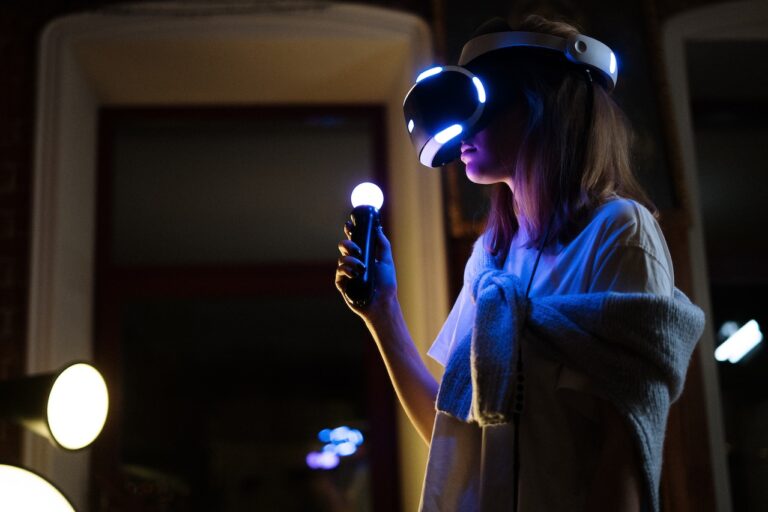Virtual Reality (VR) refers to a computer-generated simulation of a three-dimensional environment that an individual can interact with and explore. It is a technology that immerses users in a virtual world, providing a sense of presence and allowing them to experience and manipulate objects as if they were physically present in that environment.
In VR, users typically wear a headset containing a display and sensors to track their head movements. This allows them to look around and explore the virtual world more naturally and more visually. Designers create visuals and audio in VR to craft a convincing and realistic experience that engages multiple senses, heightening the sensation of being transported to an alternate reality.
Virtual reality aims to create a simulated environment that can be perceived as real. It enables users to interact with objects, navigate through spaces, and experience events that may not be possible or practical in the physical world.
Table of Contents
Explanation of the virtual reality experience
Virtual Reality (VR) works by creating a computer-generated environment that simulates a realistic and immersive experience for users. The key components involved in making VR work are:
- headset: Users wear a VR headset, which typically consists of a head-mounted display (HMD) that covers the eyes and, in some cases, the ears. The headset may also include built-in sensors to track head movements and adjust the visuals accordingly;
- display and optics: The headset’s display presents the virtual world to the user’s eyes. High-resolution screens with fast refresh rates deliver clear and smooth visuals, while optics ensure correct image appearance and accurate depth perception;
- tracking system: VR systems employ various tracking methods to track the user’s movements and enable them to interact with the virtual environment. These can include external sensors placed in the room, cameras, or inside-out tracking using built-in sensors on the headset itself. These tracking systems capture the user’s head movements and sometimes hand movements, allowing the virtual world to respond accordingly;
- input devices: VR experiences often involve user interaction, and input devices play a crucial role in enabling this. Controllers, gloves, or even full-body tracking suits capture the user’s hand and body movements, translating them into actions within the virtual environment.
Components of a typical VR system
The components of a typical VR system are:
- VR-Ready Computer: A powerful computer is required to generate the graphics and process the data needed for a smooth VR experience. It should meet the specifications recommended by the VR headset manufacturer;
- software and content: VR experiences are created using specialized software tools and platforms. Developers use 3D modeling, animation, and programming to build virtual environments and interactive elements. These experiences can range from games and simulations to educational content and training applications;
- connectivity: VR systems may require connectivity to access online content, multiplayer experiences, or updates. Wired or wireless connections are used to link the headset and other devices to the computer or gaming console.
Read also: How to become a Metaverse Architect: skills required, salary and challenges
Applications of Virtual Reality
Virtual Reality (VR) has gained popularity across various industries due to its immersive and interactive nature. Here are some top use cases and applications of VR:
- VR Gaming: VR offers gamers a truly immersive and interactive gaming experience. This allows gamers to step into virtual worlds, interact with objects, and engage in realistic gameplay;
- virtual theme parks: VR can recreate theme park rides and experiences. This enables users to enjoy thrilling adventures from the comfort of their homes;
- virtual classrooms: VR provides a virtual learning environment where students can explore interactive educational content, visit historical sites, and engage in virtual field trips;
- training simulations: Industries such as aviation, healthcare, military, and emergency response use VR to simulate realistic training scenarios for professionals. This allows them to practice skills in a safe and controlled environment;
- mental health treatment: VR-based therapy utilizes virtual environments to expose patients to trigger controlled therapeutic responses, effectively treating phobias, anxiety disorders, and post-traumatic stress disorder (PTSD).
The Future of VR Technology
Vr technology is in full development. Here are some of the features we will probably see in the future:
- wearable VR devices: VR glasses and smart contact lenses will increasingly prevail, providing users with a seamless, hands-free VR experience. These devices will integrate with everyday life, providing information, navigation, and interactive overlays;
- improved visual realism: Computer vision and graphics technology advancements will lead to more realistic and convincing VR visuals. It will blend virtual elements seamlessly with the real world;
- enhanced Interactivity: Future VR systems will offer more sophisticated interactivity. it will allow users to manipulate virtual objects, collaborate in shared VR spaces, and engage in multiplayer VR experiences;
- integration with IoT: VR will increasingly integrate with the Internet of Things (IoT). This will allow users to interact with and control smart devices and appliances through VR interfaces;
- remote collaboration: VR will enable remote collaboration by overlaying virtual representations of remote users, facilitating virtual meetings and interactions in shared VR spaces.
VR has revolutionized gaming, education, healthcare, and more
AR and VR are transformative technologies that blur the line between physical and virtual worlds. VR revolutionizes gaming, education, and healthcare, while AR enhances retail, navigation, and more.
Advancements in hardware and software offer a promising future with realistic experiences, wearable devices, and IoT integration.
Address challenges of cost, accessibility, and ethics, VR and AR will reshape industries and everyday life. Responsible adoption is crucial for harnessing their benefits. The future is bright for virtual and augmented realities.
Read also: Dubai, all about the city’s strategy to become a Metaverse hub












